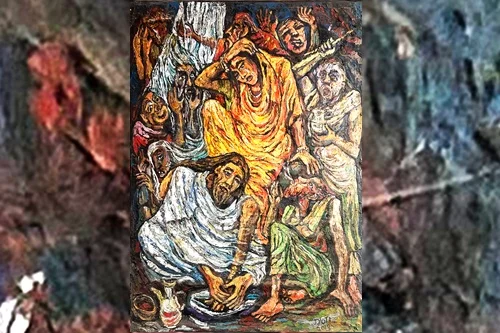People are afraid of art, because real art brings the question and the answer into your house.
Saji P Mathew OFM
Tonight’s art becomes inadequate
and useless when the sun rises in
the
morning. The mistake lies not in creating art for tonight, but in assuming
tonight’s answers will serve tomorrow’s questions. Louise Bourgeois, a French
American artist, reflected, “art is a guaranty of sanity;” but that guarantee must
be renewed with each dawn, each cultural shift, and
each evolution of human
consciousness. If some art endures through generations, it
is only because of its
capacity to speak, its ability to demand fresh interpretations that test and
challenge the new. To guarantee sanity in the coming year, 2025 must create
its
own art. Why create art? Why watch art? Why read literature? True art, in the
words of Sunil P Ilayidam, shakes that which is rigid and unchangeable. Art
serves as humanity’s persistent earthquake, destabilising comfortable certainties
and creating space
for new ways of seeing, thinking, and being
in the world. An
artist’s duty is to reflect the times, and we see this in works like Picasso’s
“Guernica,” which shattered comfortable illusions about the glory of war, forcing
viewers to confront its brutal reality. We are limited by culture, philosophy,
ethnicity,
value system, religion, and family. In each case, art serves as what
philosopher Friedrich Nietzsche called “the hammer of the gods,” breaking apart
ossified structures of thought and feeling to make room for new possibilities.
Incidentally, 2024 was the 150th anniversary of Impressionism. In 1874, 30
artists, including Claude Monet and Paul Cézanne, staged the first Impressionism
exhibition. They broke away from the academic traditions, and embraced
modernity with all its vulnerabilities
and humanness. They moved away from
subjects like, glorified history, hyped religion and myth; instead focused on the
fleeting moments of everyday existence; executed art with short, broken, and
bold brushstrokes, used unblended colours,
and articulated with the
transient
beauty of the sunlight. Art was not static and composed from a fixed
perspective anymore—art moved. The Impressionists were questioned,
ridiculed, and rejected
as ‘unfinished, vulgar, lacking structure, subversive’ by
the existing salons ruled by established academy artists and sponsored by the
government. Impressionism art movement survived, more people began
to
frequent the galleries of impressionists than the traditional official salons; and
eventually has become one of the most influential art movements in history—
thus was the birth of modern art.
What was modern art declaring?
In the opinion of Arnold Hauser, the author of
The Social History of Art, it tried to say that truth and realities as we have known
is trembling from its foundations. In the second half of the 19th century, in
Capital, Karl Marx says, ‘all that is solid melts into air’. What we thought as
eternal will succumb to decay. TS Eliot borrows a nursery rhyme to say on a
serious note in his The Waste Land, ‘The London Bridge is falling down’. However
big or stable something would seem, in the words of WB Yeats, ‘things fall apart’.
Modernism eventually becomes postmodernism with its watchword, relativism.
Nothing is permanent, everything is changing; and even what you see at this
fleeting moment exists in relation to culture, society, and historical context; and
not absolute.
People are afraid of serious art, for it speaks to their ultimate depths. While
visiting the art ashram of Jyoti Sahi, he extensively engaged me with stories,
narratives, and meaning of numerous works of art. As we moved from one
painting to another we came across a painting portraying Jesus washing the feet
of a woman disciple. Jyoti Sahi almost moved on, not wanting to say much about
it; but commented that nobody would want such art in their chapels or churches;
for it would constantly challenge patriarchy and colonial religion.
Art in 2025 must challenge majoritarian and religious fundamentalism, Hindutva
nationalism, fascism, crony capitalism, erosion of democracy, environmental and
climate change, gender inequality, caste discrimination, and, on a personal front,
mental illness.
Creating art looks foolish to the nationalist, capitalist, patriarchal society— it is a
very dangerous game. It is like discussing colour with someone who is colour-
blind. It is a real challenge; more and more in most conservative and rigid
businesses and establishments people do not encourage art, lest they be
challenged and forced to change. People are afraid of art, because real art brings
the question and the answer into your house.
Caption to be placed near the image:
Jesus Washing the Feet of a Woman Disciple
Jyoti Sahi
Even now the Church can’t fully accept the fact that Jesus would have washed the feet of
women. And the men around in the picture, whom the artist calls as navarasas (different
moods and passions), are ill treating, mocking, and questioning both Jesus and the
woman—one is spiting, another is hitting, one is hiding his face in shame, and so on. No
church wanted this picture; they can’t comprehend how it is Christian.